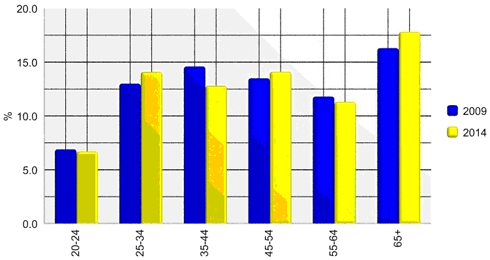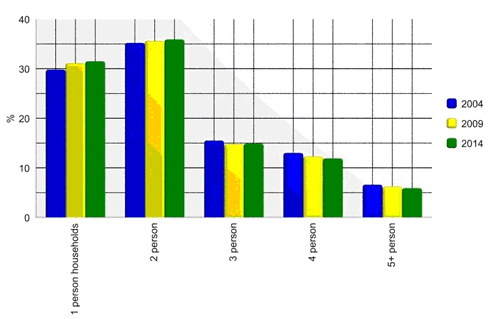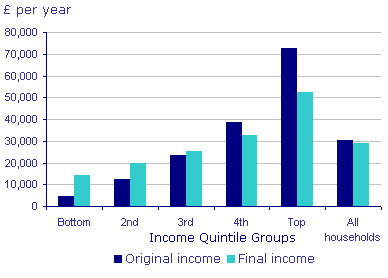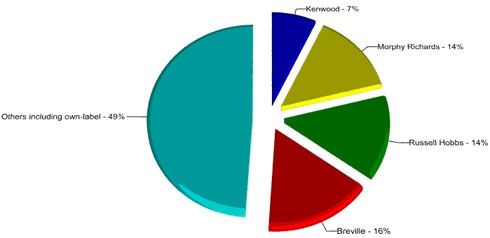The marketing of kettles: segmentation, targeting And positioning strategies for the Russell Hobbs 13775 kettle.
This report uses marketing theories and models in order to critically analyse the market segmentation, targeting and positioning strategies for the Russell Hobbs 13775 cordless jug kettle. Segmentation, targeting and positioning are important parts of the marketing strategy which help companies to tailor their products better. Figure 1 illustrates best the steps and the connection between these three vital actions used by marketers to reach their customers.

Figure 1: The main steps in market segmentation, targeting and positioning. Source: Doyle and Stern (2006) p.64
SEGMENTATION
According to Masterson and Pickton (2004, p. 79), the market segmentation can be defined as: “the process of dividing a total market into subgroups (segments) such that each segment consists of buyers and users who share similar characteristics but are different from those in the other segments.”
Segmentation is important, especially in the kettles industry, because a single product can not satisfy all the customers and the need for diversity is vital. According to their website (2010), Russell Hobbs produces 16 different kettles and the new Russell Hobbs Black Cordless Kettle (Model No. 13775) is especially created to suit every pocket and offers real consumer benefits and technological advancements. Therefore, the company understands the need to offer their customers the best products. Masterson and Pickton (2004) also admit that the main role of segmentation is to build growth and profitability, promote the retention of customers and to stimulate the company to innovate.
Segmentation in consumer markets
This section discusses the four main forms that Russell Hobbs uses in segmenting their consumer market.
- Demographic Segmentation –This is frequently used, mainly because it is easy to collect all the relevant information from government statistics. (Blythe, 2005)
For the Russell Hobbs 13775 kettle, demographic segmentation is mainly based on the age, household composition and gender factors, which need a careful analysis. The Future Foundation Research Organization (2009) states that the demographic landscape of the UK will shift considerably over the next five years, given the total UK population is set to grow by 3.6% to reach 63.7 million by 2013. This means that there will be certain groups of the population that will see larger increases than others, which can produce various implications and opportunities for the Russell Hobbs kettles.
Age and gender
According to Mintel (2009), there are differences between the buying patters of younger consumers and consumers aged 35 and over. Although kettles are bought by a high proportion of all demographics, ownership of kettles tends to be lowest among under-25s and the highest rate of purchase is among consumers aged 35-44 years old (who are looking for premium products), and more women than men are buying kettles. The same study shows that the last five years have seen an ageing of the population, with the over-45 age group increasing in number. Over the next five years, the strongest growth is projected for the over-65s (figure 2), Mintel (2009).
The Russell Hobbs 13775 cordless jug is priced at £32.49, meaning that the age segmentation seeks to tailor also the youngest consumers and first time buyers (aged 15-25), with a constrained income, but also the oldest customers (aged 55-64 years old) who are likely to be attracted to lower cost kettles, with traditional features and design elements, and who have known the brand for over 50 years and are interested in purchasing a classic, traditional product.
Hooley, Piercy and Nicoulaud (2008) affirm that age and gender have been used as a basic segmentation variable in many markets because they can be easily measured and they are also useful for media selection purposes.

Figure 2. Structure of the UK population, by age, 2009 and 2014. Source: Mintel (2009).
Household composition
The Russell Hobbs kettle is part of the small kitchen appliances group, which is bought by householders as an economic unit. Its 1.7L capacity is design to target more than one household member, trying to satisfy the need of a family unit. This segmentation can increase the Russell Hobbs 13775 cordless jug sales, which will be bought by more than a single-person household.
Palmer (2009) says that households differ in their size and composition, but they can help companies to understand diverse buying behaviours. Moreover, the author also believes that the composition of individuals’ roles within the household structure is also an important indicator. As Mintel (2009) presents (Figure 3), most families have two or more members, and more women than men are buying kettles. In addition, the household segmentation helps Russell Hobbs to better target their segments (mainly women), to select positioning strategies and to formulate the marketing mix.

Figure 3. UK households and size of households, 2009 and 2014. Source: Mintel (2009).
Household Income
Russell Hobbs uses income segmentation, targeting consumers with an average income. The price of £32.49 per kettle is affordable and attractive to most of the households that earn less than £ 30,000 per year (the average income per household in the UK, Figure 4, Office for National Statistics, 2009). Palmer (2009) affirms that most marketers are trying to gain an increased share of discretionary income, and when the individuals’ incomes increase, their expenditure on certain products also increases, and customers could prefer the premium, more expensive products and new models should be designed.

Figure 4. Average income per household, 2007/08, UK. Source: Office for National Statistics (2009).
According to Blythe (2005), marketers need to monitor all these changes in the demography if they are to remain able to segment the market effectively. Moreover, the geographic and psychographic segmentation also play an important role in the company’s strategies.
- Geographic Segmentation – Includes “dividing a market into different geographical units such as nations, states, regions, counties, cities, or neighbourhoods” (Kotler and Armstrong, 2004, p. 239).
The Russell Hobbs Company decided to operate and sell its 13775 model kettle in most of the geographical areas of the UK, building a long and trusted heritage across the country (Russell Hobbs, 2010). - Psychographic Segmentation –Attempts to measure and understand peoples’ lifestyles, values, personalities, attitudes, social classes and it is more predictive because it addresses directly the issue of understanding buyer and usage behaviour through an understanding of the buyers and users themselves. (Masterson and Pickton, 2004)
- Geographic Segmentation – Includes “dividing a market into different geographical units such as nations, states, regions, counties, cities, or neighbourhoods” (Kotler and Armstrong, 2004, p. 239).
This variable helps Russell Hobbs to develop segment profiles. The Russell Hobbs Black Cordless Kettle (Model No. 13775) reflects a particular type of buyer and his lifestyle. As a result, the company segments its market by offering real benefits and satisfying consumers’ thirst for creating a new and fresh feel in the kitchen. The kettle particularly appeals to tea lovers, who will have their cuppa ready in no time at all, and the 360º base with cord storage makes it suitable for both left and right handed users (Russell Hobbs, 2010).
Behavioural Segmentation
They are an important part of the behavioural segmentation and show that a product may provide a variety of benefits to different people. (Palmer, 2009) For instance, the Russell Hobbs 13775 kettle targets large families; however, the same kettle can be purchased by one segment of customers who want to have a quick cup of tea or by another using it for boiling water for cooking. Others might choose it because of its stylish features, with an opened handled design and modern black finish with stainless steel spout, which addsto its visual appeal (Russell Hobbs, 2010). And some other segments might buy it as a present for people moving into a new home, or it can be a reliable purchase for first-time buyers. As Masterson and Pickton (2004, p.74) assert, each benefit “can provide a substantial market segment and help to create opportunities for brand positioning.”
TARGETING
According to Blythe (2005), after dividing the market into segments, managers must decide which segment will be the best to target. That might be the most profitable segment, or a particular segment currently neglected by the market. As a result, the process of selecting a segment to aim for is called targeting. Kotler and Armstrong (2004) identify three main strategies that can be used to enter and exploit those segments (Figure 5):
- undifferentiated strategies
- differentiated strategies
- concentrated strategies

Figure 5. Target market strategies. Source: Kotler and Armstrong (2004), p. 252
Undifferentiated strategies
It is used by Russell Hobbs because the aim of the strategy is to offer a basic product that would suit and be used by almost all age groups and lifestyles. (Blythe, 2005) The 13775 cordless kettle targets tea lovers and families who tend to use the 1.7 L capacity. Although the product has several features, including a water gauge and removable washable filter, 3kw concealed element, 360-degree rotational base with cord storage and a power on neon indicator, the use of a kettle is much the same for all the consumers. (Russell Hobbs, 2010) Masterson and Pickton (2004) point out that by using this strategy the company can minimise its production costs, offer products at competitive prices and maintain a specific image with consumers.
- Differentiated strategies – Focus on targeting two or more markets, each of them receiving a different marketing programme (Masterson and Pickton, 2004)
Even though the main strategy is based on offering the product to customers with similar needs, as mentioned before, a few forms of differentiation take place. Russell Hobbs offers 16 different models of kettles (Russell Hobbs, 2010), meeting the needs of different targeted segments, but the 137775 model kettles is particularly addressed to middle class consumers (because of the price, £32.49 per kettle) and those with more than one in thehousehold (because of the capacity), targeting the younger segment, with a modest income or the older generation, who are looking for a basic product, easy to use, timeless and stylish. However,the company does not use a different marketing programme for each of them.
- Concentrated strategies – The company chooses to target a large share of one or a few segments ( Kotler and Armstrong, 2004)
The advantage of this strategy is the fact that the company gets to know the needs of its target segment extremely well and focuses all its efforts in satisfying their needs, achieving valuable advantages over its competitors. (Palmer, 2009) Russell Hobbs prefers to diversify in several market segments and does not use this strategy, mainly because it can be quite risky when larger competitors decide to enter the same segment or when the only segment chosen turns sour. (Kotler and Armstrong, 2004) However, at this stage there are also other factors that need to be taken into account, such as the company resources, the product’s life cycle stage, market variability and the competitors’ marketing strategies. (Kotler and Armstrong, 2004)
POSITIONING
Another way for a company to improve its competitiveness is through positioning strategies. According to Masterson and Pickton (2004) positioning forms a direct link between the target marketing strategies and marketing programmes. Kotler and Armstrong (2004) affirm that positioning begins with differentiating the company’s offers so that it will give consumers more value than competitors’ offers do.
According to Masterson and Pickton (2004), a range of different strategies can be considered when a company position itself against the competition:
- positioning on attributes/product features
- positioning by price/quality
- positioning for specific usage occasions
- positioning on benefits or needs
- positioning by the product user
- positioning against another brand or with respect to a competitor
- positioning with respect to another product class
Russell Hobbs uses several of these strategies when positioning its 13775 cordless jug kettle. Its entire market position“is a result of the strength of its brands; the breadth, quality and innovation of its products; its strong relationships with retailers; and its outsourcing strategy.” (Mintel, 2009) Firstly, the product differentiates itself through price, which is relatively affordable to most of the consumers. Moreover, the price of £32.49 per kettle offers value for the money and adequate quality. Their strategy is to move away from non-core and entry-price brands and the aim is to be a major supplier to all small domestic appliance retailers, offering a range of products with a mix of quality, value and service. (Mintel, 2009) Secondly, the special featuresmake it a trusted and easy to use kitchen appliance. The company emphasises its distinctive features, such as: water gauge, with a 1.7 L capacity and 3kw rapid boil concealed element, 360º rotational base with cord storage and power on neon indicator. The kettle also features a water level window, a water filter (which prevents particles going into the drink) and the cordless jug. (Russell Hobbs, 2010)
According to Mintel (2009) the cordless kettles have an advantage over their corded competitors, and they account for more than 90% of kettles by value, while the corded sector has continued to decline in importance, and that makes the Russell Hobbs 13775 kettle an attractive and desired product. Mintel (2009) also presents the main competitors for Russell Hobbs (Figure 6) and it can easily be noted that the company already shares 17.2 % of the market, being among the three most preferred brands, with Morphy Richards and Breville as the main competitors and significant brands in the low to mid-price points.

Figure 6. Brand shares in the UK kettles market, by value, 2006-2008. Source: Mintel (2009)
Conclusively, Russell Hobbs 13775 kettle is positioned as a traditional and reliable product. The statement: “we work very hard at Russell Hobbs to keep ahead of the latest trends and stay ahead of the competition!” (Russell Hobbs, 2010) shows a strong commitment in meeting their customers’ needs and fighting against competition. Russell Hobbs is a company with a history of innovation, operating in the main geographical areas of the UK and has to consider all the aspects discussed here in order to maintain its position in the market.
Bibliography
Blythe, J. (2005) “Essentials of marketing”, 3rd edition, Harlow, Financial Times Prentice Hall.
Doyle, P., and Stern, P. (2006) “Marketing management and strategy”, 4th edition, Harlow, Financial Times Prentice Hall.
Hooley, G., Piercy, N.F., and Nicoulaud B. (2008) “Marketing strategy and competitive positioning”, 4th edition, Harlow, Financial Times Prentice Hall.
Kotler, P., and Armstrong, G. (2004) “Principles of marketing”, 10th edition, N.J., Pearson Education.
Masterson, R., and Pickton, D. (2004) “Marketing. An introduction”, London, McGraw-Hill.
Mintel (2009) Buying for the Home Online – UK – May 2009 [online] Available from:
http://academic.mintel.com/sinatra/oxygen_academic/search_results/show&/display/id=393969 [Accessed 21 March 2010].
Office for National Statistics (2009) “UK Government Debt & Deficit” [online] Available from http://www.statistics.gov.uk/cci/nugget.asp?ID=277 [Accessed 21 March 2010]
Palmer, A. (2009) “Introduction to marketing: theory and practice” 2nd edition, Oxford, Oxford University Press.
Russell Hobbs (2010) “Black jug kettle” [online] Available from http://www.russellhobbs.co.uk/product_details.html?products_id=39 [Accessed 10 March 2010].
The Future Foundation (2009) “The New Demographic Landscape” [online] Available from: http://www.futurefoundation.net/page/view/the_new_demographic_landscape [Accessed 15 March 2010].